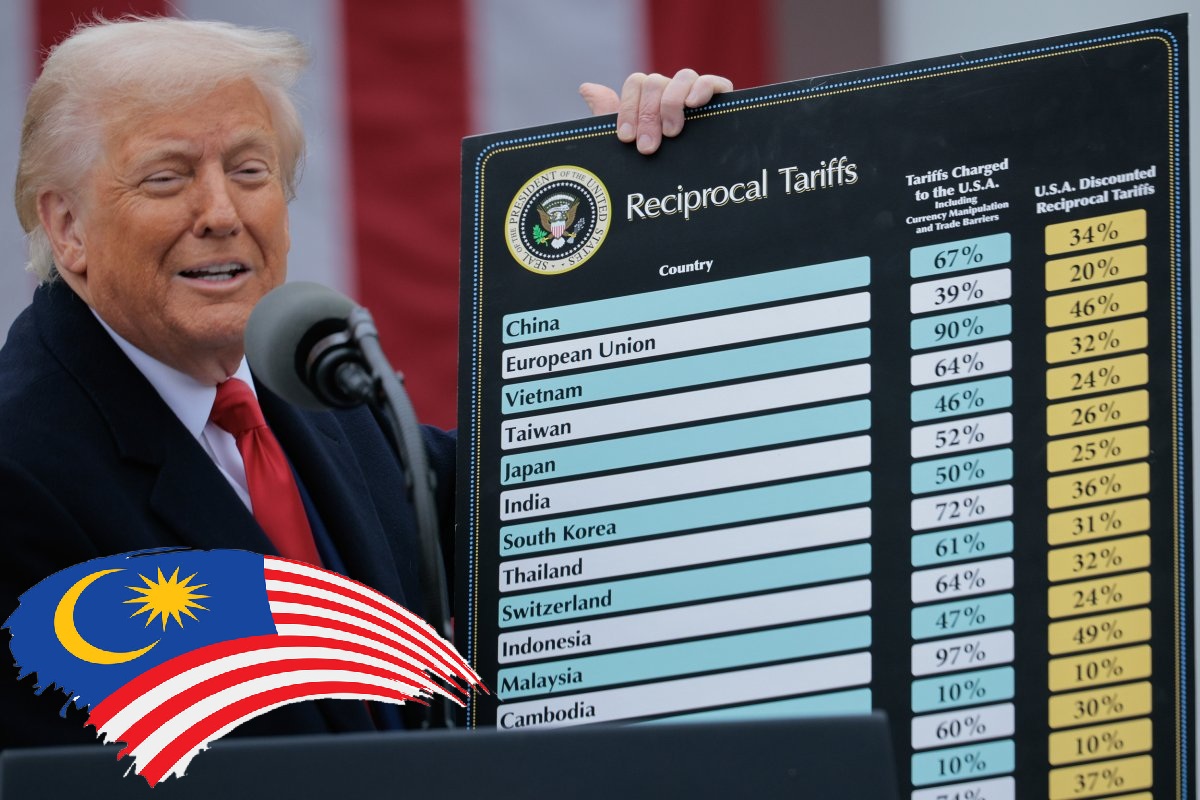
Published by TheStar, FocusMalaysia, MYsinchew & AstroAwani, image by FocusMalaysia.
Trump’s sweeping tariffs—targeting a broad range of countries, including ASEAN nations and other key trade partners, with rates ranging from 24% (Malaysia) to 49% (Cambodia)—represent perhaps the most aggressive U.S. protectionist turn since the Smoot-Hawley tariffs of the 1930s. Yet, a closer examination beneath the dramatic posturing reveals that this latest confrontation is less a coherent and practical trade strategy than a politically expedient gambit—one that underscores the fragility of U.S. leverage in an increasingly decentralised global economy. Meanwhile, the countries in the crosshairs now face a strategic opportunity to accelerate long-overdue reforms: diversifying trade partnerships, reducing dependency on the dollar, and investing in sovereign innovation.
The Tariff Formula: Arbitrary, Unilateral, and Self-Defeating
The new measures appear far from reciprocal in any conventional sense. Countries that maintain low or even negligible tariffs on U.S. goods have been hit with steep penalties, seemingly based on the size of the U.S. trade deficit with them rather than their actual trade practices. Malaysia, for instance, had an average Most Favored Nation tariff rate of just 5.6% in 2023—yet its exports to the U.S. are now subject to a 24% tariff. Similarly, countries like Vietnam, which has significantly reduced tariffs on U.S. goods, and Israel, which has virtually eliminated them altogether, have still found themselves heavily penalised under this new regime.
More critically, the formula underpinning these tariffs rests on pseudoscientific elasticity assumptions. The United States Trade Representative’s “reciprocal tariff” model assumes a 4:1 ratio between price increases and demand contraction, alongside a 0.25% import price rise per 1% tariff—figures that appear to have been plucked from thin air. By arbitrarily setting elasticity coefficients to 1, the model effectively reduces to a crude deficit-to-imports ratio, rendering its technical veneer meaningless.
Notably, selective strategic goods remain untouched, underscoring the policy’s ad hoc nature and revealing a tacit admission that full decoupling from global supply chains remains impractical.
Beyond puzzling mathematics, there is a more fundamental question of economic rationality. Proponents may argue tariffs will “reshore” manufacturing and fund tax cuts. Reality tells a different story.
Rising tariffs are especially risky as global competition erodes America’s technological edge—making it unlikely that foreign suppliers will absorb the cost, contrary to Trump’s assumptions, and more likely that domestic producers will have no choice but raise prices.
Should inflation mount and growth stall, the United States could be staring down the barrel of stagflation—a combination of rising prices and weakening economic activity. In March 2025, the Conference Board’s Consumer Confidence Index fell 7.2 points—a harbinger of slowed spending. Even more troubling, Harvard officials estimate that 85% of U.S. families require some form of financial assistance. This aligns with earlier U.S. Census data indicating that the top 20% of earners control a disproportionate share of disposable income. Beyond raising serious concerns about striking domestic income disparities and spending ability, these factors suggest that the global impact of U.S. tariffs may be overstated.
High tariffs subsidize inefficiency. As foreign parts become costlier or firms struggle to compete globally, domestic producers may grow complacent, reducing incentives for innovation and efficiency.
Modern manufacturing depends on complex, cross-border supply chains. Raising tariffs can hamper these networks, create uncertainty for businesses, and deter long-term investments. Large U.S. multinationals with intricate production chains could be hit especially hard. Apparel giants like Nike and Gap—reliant on Vietnamese factories—have already seen stock prices plummet 7% on supply chain fears.
Strengthening the dollar while imposing steep tariffs represents an inherently contradictory strategy (see “Rising Above Trump Tariffs: How a Resilient Global Economy Outlasts U.S. Protectionism”). Further straining Washington’s already fragile ties with key partners may accelerate “de-dollarization” dynamics, undermining long-standing economic stability and diminishing the appeal of “American exceptionalism” as an investment thesis. This, in turn, could trigger a prolonged bear trend in U.S. securities markets, deterring investors from “buying the dip.”
Even without official retaliation, global sentiment may turn against U.S. brands in an era of viral boycotts. Canada and several European countries have already launched “buy local” campaigns, compounding the risks for U.S. companies reliant on global goodwill.
Historical parallels are ominous. The Smoot-Hawley tariffs deepened the Great Depression by strangling global trade. Today, with U.S. technological dominance waning and rivals like China closing innovation gaps, Trump’s gamble looks even riskier.
Even though Trump’s rhetoric suggests there may be rational motivations behind dramatic tariffs—such as pressuring other countries into making “phenomenal” concessions or attracting capital inflows by encouraging foreign firms and American multinationals to build plants on U.S. soil—the sheer absurdity of this strategy, given all the aforementioned factors, is monumental. It resembles an attempt to execute a “dead loop” while flying dangerously close to the ground.
We should also not dismiss the possibility that these dramatic moves are merely political theatrics, aimed at countering persistent domestic opposition and unprecedented sabotage from entrenched elites—many of whom have recently made a habit of criticizing Trump for failing to deliver on his campaign promises and his commitment to “America First.” During the 2024 election, Trump repeatedly vowed to impose steep tariffs to protect American jobs. In this context, the administration’s flurry of tariff announcements may be more about placating a restless voter base than about sound economic policy—especially given the deep uncertainty surrounding the actual impact of these measures on the U.S. economy.
The Global Fallout: More Complexity Than Catastrophe
Trump’s tariffs will undoubtedly ripple through the global economy, with even indirect disruptions affecting production and jobs across intricately interwoven supply chains. But despite alarmist headlines, the reality is more nuanced: not all sectors or countries will be equally affected—and not all impacts will be negative.
Short-term volatility is almost certain, with initial reactions including price swings and supply chain adjustments. The severity of the fallout depends on the goods involved—commodities and undifferentiated products can be rerouted fairly quickly, while specialised components like semiconductors or chipsets, deeply embedded in global production chains, will take longer to redirect.
Yet the complexity cuts both ways. The U.S. has excluded many specialised goods from tariffs—tacitly admitting its reliance on high-tech imports. For instance, much of Malaysia’s electronics exports, including semiconductors, remain exempt. This selectivity highlights both the policy’s ad hoc nature and the limits of U.S. decoupling.
Exporters of complex goods facing tariffs may incur short-term losses, while for those dealing in bulk commodities with broad market appeal, redirected exports could create downward price pressure in non-U.S. markets. Some importers may briefly benefit from lower prices, but discounts are typically modest, and few exporters can sustain below-cost sales for long. Countries reliant on undifferentiated exports will bear the greatest strain—especially if global uncertainty continues to suppress demand.
Moreover, because this tariff escalation is systemic—targeting not just Malaysia but a broad coalition of economies—some inefficiencies may offset one another. What one nation diverts, another may absorb. However, this redistribution won’t happen overnight. Supply chains for complex goods will take months, if not years, to reconfigure.
Furthermore, countries heavily reliant on raw materials or undifferentiated exports face additional second-order risks. If U.S. tariffs depress global demand and trigger a broader economic slowdown, commodity prices could fall—hurting exports, weakening currencies, and straining public revenues across vulnerable economies.
As EMIR Research warned as early as April 2022 in “Petrodollar Warfare: Oil, Russia and the Future of the Dollar,” supply-chain development and diversification is not a contingency to be postponed—it is a strategic imperative amid today’s geopolitical realities.
Reaction Without Retaliation: Why Strategic Patience May Prove Wiser
While it may be tempting to retaliate with matching tariffs, doing so could prove self-defeating. Trade barriers harm not just those they target, but also those who erect them. For countries with limited capacity for import substitution (e.g., underdeveloped industrial bases) or undiversified supply chains, escalating a tariff war would only amplify domestic vulnerabilities.
At the same time, surrendering to “phenomenal” concessions—as vaguely demanded by Trump—would be equally unwise. In some capitals, vested interests are already leveraging tariff threats to push for sweeping concessions to U.S. demands. But such reactions are often driven by panic rather than pragmatism. Malaysia, for instance, is reportedly under scrutiny for policies related to halal certification, digital regulation, and preferential treatment for local firms. Yet many of these measures are sovereign decisions rooted in national values and development goals—they must not be traded away under duress!
Rather than overreacting, countries caught in this crossfire must use the moment to do what should have been initiated long ago:
- Advance strategic import substitution—but not through tariffs. Protectionism doesn’t breed innovation; smart domestic policy, investment in R&D, workforce upskilling, and tech transfer does.
- Accelerate supply chain diversification. Less differentiated products can be redirected quickly, but complex goods—especially those not yet targeted by U.S. tariffs—require long-term planning. For Malaysia, where electronics and electrical components make up over 40% of exports (many bound for the U.S.), the risk of future tariff inclusion is real. Waiting for the next White House announcement would be a costly mistake.
- Deepen multilateral trade ties and South-South cooperation. Malaysia and ASEAN should strengthen engagement with RCEP, CPTPP, and key trading blocs like the EU and GCC. Expanding into African, Latin American, and Middle Eastern markets is equally essential. Malaysia’s proactive entry into the expanded BRICS framework also opens promising new corridors for trade, investment, and knowledge exchange.
Asia’s major economies have already begun charting their counterstrategy. China, Japan, and South Korea are deepening trilateral ties, including joint investment in semiconductor supply chains. These are long-term resilience strategies—not just reactions. Malaysia and ASEAN must act decisively to keep pace.
Malaysia’s response, as outlined in Prime Minister’s statement on the U.S. Reciprocal Tariffs (April 6, 2025), reflects strategic maturity: no retaliatory tariffs, but instead a focus on preserving investor confidence, safeguarding sovereign policy space, and accelerating economic transformation.
Trump’s tariffs are not just trade tools—they’re geopolitical signals. They reflect the U.S.’s retreat from its role as steward of a rules-based global trade order. The future of the global economy—especially for middle powers like Malaysia—depends on our ability to withstand such disruptions. The answer isn’t impulsive reaction, but strategic resilience, diversified alliances, and assertive sovereign agency.
Dr Rais Hussin is the Founder of EMIR Research, a think tank focused on strategic policy recommendations based on rigorous research.

